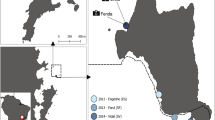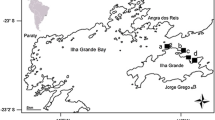Abstract
The effects of invasive species on native fauna are understudied in marine ecosystems, even though the impact of introduced species must be taken into consideration for proper conservation and management. The main aim of this study was to investigate the effects of invasive algae on one of the highest diversity assemblages in the Mediterranean, the coralligenous. Two manipulative experiments were designed to study the effects of overgrowth of invasive species on juvenile colonies of the Mediterranean gorgonian Paramuricea clavata, an important structural species in coralligenous assemblages. The experiments were conducted in two French marine protected areas, Port-Cros National Park and Scandola Regional Park, which are separated by hundreds of km and are invaded by Caulerpa racemosa and Womersleyella setacea, respectively. Both invasive species had a strong and consistently negative effect on different components of fitness. This finding was demonstrated by lower survivorship, higher necrosis rates and lower biomass in P. clavata colonies exposed to invasive algal overgrowth compared to the controls. Because invasive species affected the viability of juvenile colonies of P. clavata, we conclude that the persistence of P. clavata populations affected by invasion can be jeopardized, especially in the case of populations already impacted by mass mortalities associated with climate warming.






Similar content being viewed by others
References
Airoldi L (1998) Roles of disturbance, sediment stress, and substratum retention on spatial dominance in algal turf. Ecology 79:2759–2770
Airoldi L, Rindi F, Piazzi L, Cinelli F (1995) Distribution of Polysiphonia setacea (Rhodomelaceae, Rhodophyta) Hollenberg in the Mediterranean and possible means of diffusion. Biol Mar Med 2:343–344
Andromède océanologie (2011) Etude et cartographie des biocénoses marines de la Réserve naturelle de Scandola, Corse. 136 p
Athanasiadis A (1997) North Aegean Marine Algae. Womersleyella setacea (Hollenberg) R. E. Norris (Rhodophyta, Ceramiales). Bot Mar 40:473–476
Baldacconi R, Corriero G (2009) Effects of the spread of the alga Caulerpa racemosa var. cylindracea on the sponge assemblage from coralligenous concretions of the Apulian coast (Ionian Sea, Italy). Mar Ecol 30:337–345
Ballesteros E (2006) Mediterranean coralligenous assemblages: a synthesis of present knowledge. Oceanogr Mar Biol Annu Rev 44:123–195
Belsher T, Houlgatte E, Boudouresque CF (2003) Cartographie de la praire a Posidonia oceanica et des principaux facies sedimentaires marins du parc national de Port (France, Mediterranée) In: Proceed 2nd Med Symp Mar Vegetation, Athens
Bianchi CN, Dore G, Morri C (1995) Guida del subacqueo naturalista: Mediterraneo e tropici. Ed Arch Fot Sard Nuo, 1–278
Boudouresque CF, Verlaque M (2002) Biological pollution in the Mediterranean Sea: invasive versus introduced macrophytes. Mar Poll Bull 44:32–38
Carlton JT (2000) Global change and biological invasions in the oceans. In: Mooney HA, Hobbs RJ (eds) Invasive species in a changing world. Island press, Covelo, pp 31–53
Cebrian E, Ballesteros E (2009) Temporal and spatial variability in shallow- and deep-water population of the invasive Caulerpa racemosa var. cylindracea in the Western Mediterranean. Est Coast Shelf Sci 83:469–474
Cebrian E, Rodríguez-Prieto C (2012) Marine Invasion in the Mediterranean Sea: the role of abiotic factors when there is no biological resistance. PLoS One 7(2):e31135. doi:10.1371/journal.pone.0031135
Cebrian E, Uriz MJ, Garrabou J, Ballesteros E (2011) Sponge mass mortalities in a warming Mediterranean Sea: are cyanobacteria-harboring species worse off? PLoS One 6(6):e20211. doi:10.1371/journal.pone.0020211
Cerrano C, Bavestrello G, Bianchi N, Cattaneo-Vietti R, Bava S, Morganti C, Morri C, Picco P, Sara GP, Chiapparelli S, Siccardi A, Sponga F (2000) A catastrophic mass-mortality episode of gorgonians and other organisms in the Ligurian Sea (NW Mediterranean), summer 1999. Ecol Lett 3:284–293
Cerrano C, Arillo A, Azzini F, Calcinai B, Castellano L, Muti C, Valisano L, Zega G, Bavestrello G (2005) Gorgonian population recovery after a mass mortality event. Aquat Conserv Mar Freshw Ecosyst 15:147–157
Cinelli F, Balata D, Piazzi L (2007) Threats to coralligenous assemblages: sedimentation and biological invasions. Hydrobiol 398(399):91–100
Coma R, Ribes M, Zabala M, Gili JM (1998) Growth in a modular colonial marine invertebrate. Est Coast Shelf Sci 47:459–470
Coma R, Pola E, Ribes M, Zabala M (2004) Long-term assessment of temperate octocoral mortality patterns, protected vs. unprotected areas. Ecol Appl 14:1466–1478
Coma R, Ribes M, Serrano E, Jiménez E, Salat J, Pascual J (2009) Global warming-enhanced stratification and mass mortality events in the Mediterranean. Proc Natl Acad Sci USA 106:6176–6181
Crisci C (2011) Effets du changement climatique sur les écosystèmes littoraux de la Mer Méditerranée Nord-occidentale: étude de la relation entre les conditions de température et la réponse biologique pendant les événements de mortalité massive. PhD Université de la Méditerranée (Marseille, France), 198 pp
Cupido S, Cocito S, Sgorbini A, Bordone G, Santangelo G (2008) Response of a gorgonian (Paramuricea clavata) population to mortality events: recovery or loss? Aquatic Conser Mar Freshw Ecosyst 18:984–992
Galil BS (2009) Taking stock: inventory of alien species in the Mediterranean sea. Biol Inv 11:359–372
Garrabou J, Coma R, Bensoussan N, Chevaldonné P, Cigliano M, Diaz D, Harmelin JG, Gambi MC, Kersting DK, Lejeusne C, Linares C, Marschal C, Pérez T, Ribes M, Romano JC, Serrano E, Teixidó N, Torrents O, Zabala M, Zuberer F, Cerrano C (2009) Mass mortality in Northwestern Mediterranean rocky benthic communities: effects of the 2003 heat wave. Global Chang Biol 15:1090–1103
Gili JM, Coma R (1998) Benthic suspension feeders: their paramount role in littoral marine food webs. Trends Ecol Evol 13:316–321
Harmelin JG, Marinopoulos J (1994) Population structure and partial mortality of the gorgonian Paramuricea clavata (Risso) in the north-western Mediterranean (France, Port-Cros Island). Mar Life 4:5–13
Jung V, Thibaut T, Meinesz A, Pohnert G (2002) Comparison of the wound-activated transformation of caulerpenyne by invasive and noninvasive Caulerpa species of the Mediterranean. J Chem Ecol 28:2091–2105
Kuffner IB, Walters LJ, Becerro MA, Paul VJ, Ritson-Williams R, Beach KS (2006) Inhibition of coral recruitment by macroalgae and cyanobacteria. Mar Ecol Prog Ser 323:107–117
Linares C, Coma R, Diaz D, Zabala M, Hereu B, Dantart L (2005) Immediate and delayed effects of a mass mortality event on gorgonian population dynamics and benthic community structure in the NW Mediterranean Sea. Mar Ecol Prog Ser 305:127–137
Linares C, Doak D, Coma R, Diaz D, Zabala M (2007) Life history and viability of a long-lived marine invertebrate: the octocoral Paramuricea clavata. Ecology 88:918–928
Linares C, Coma R, Zabala M (2008a) Restoration of threatened gorgonian populations: an experimental and modelling approach. Biol Conserv 141:427–437
Linares C, Coma R, Zabala M (2008b) Effects of a mass mortality event on gorgonian reproduction. Coral Reefs 27:27–34
Linares C, Coma R, Garrabou J, Bianchimani O, Drap P, Serrano E, Zabala M (2009) Contribution to the conservation of coralligenous communities through studies on population ecology of Mediterranean gorgonians. In: Proceedings of the first symposium on the conservation of the coralligenous and other calcareous concretions, RAC/SPA publ., Tunis, pp 106–112
Linares C, Zabala M, Garrabou J, Coma R, Diaz D, Hereu B, Dantart L (2010) Assessing the impact of diving in coralligenous communities: the usefulness of demographic studies of red gorgonian populations. Sci Rep Port-Cros Natl Park Fr 24:161–184
Linares C, Cebrian E, Coma R (2012) Effects of turf algae on recruitment and juvenile survival of gorgonians. Mar Ecol Prog Ser 452:81–88
Mokhtar-Jamaï K, Pascual M, Ledoux JB, Coma R, Féral JP, Garrabou J, Aurelle D (2011) From global to local genetic structuring in the red gorgonian Paramuricea clavata: the interplay between oceanographic and limited larval dispersal. Mol Ecol 20:3291–3305
Nizamuddin M (1991) The green marine algae of Libya. Elga, Bern
Norse EA (1993) Global marine biological diversity: a strategy for building conservation into decision making. Island Press, Washington, DC
Nugues MM, Smith GW, Van Hooindonk RJ, Seabra MI, Bak RPM (2004) Algal contact as a trigger for coral disease. Ecol Lett 7:919–923
Perez T, Garrabou J, Sartoretto S, Harmelin JG, Francour P, Vacelet J (2000) Mortalité massive d’invertébrés marins: Un événement sans précédent en Méditerranée nord-occidentale. CR Acad Sci Paris III 323:853–865
Piazzi L, Meinesz A, Verlaque M, Akçali B, Antolic B, Argyrou M, Balata D, Ballesteros E, Calvo S, Cinelli F, Cirik S, Cossu A, D’Archin R, Djellouli SA, Javel F, Lanfranco E, Mifsud C, Pala D, Panayotidis P, Peirano A, Pergent G, Petrocelli A, Ruitton S, Žuljević A, Ceccherelli G (2005) Invasion of Caulerpa racemosa (Caulerpales, Chlorophyta) in the Mediterranean Sea: an assessment of the spread. Crypt Algol 26:189–202
Ribera MA, Boudouresque CF (1995) Introduced marine plants, with special reference to macroalgae: mechanisms and impact. Progr Phycol Res 11:217–268
Ruitton S, Javel F, Culioli JM, Meinesz A, Pergent G, Verlaque M (2005) First assessment of the Caulerpa racemosa (Caulerpales, Chlorophyta) invasion along the French Mediterranean coasts. Mar Pollut Bull 50:1061–1068
Schaffelke B, Smith JE, Hewitt CL (2006) Introduced macroalgae—a growing concern. J Appl Phycol 18:529–541
Somot S, Sevault F, Deque M, Crepon M (2008) 21st century climate change scenario for the Mediterranean using a coupled atmosphere–ocean regional climate model. Global Planet Chang 63:112–126. doi:10.1016/j.gloplacha.2007.10.003
Teixidó N, Garrabou J, Harmelin JG (2011) Low dynamics, high longevity and persistence of sessile structural species dwelling on Mediterranean coralligenous outcrops. PLoS One 6(8):e23744. doi:10.1371/journal.pone.0023744
Thomsen MS, Wernberg T, Tuya F, Silliman B (2009) Evidence for impacts of nonindigenous macroalgae: a meta-analysis of experimental field studies. J Phycol 45:812–819
Verlaque M (1989) Contribution to the marine algal flora of the Mediterranean: rare or new species for the French coasts. Bot Mar 32(2):101–113
Verlaque M (1990) Flore marine de la région de Galeria. Trav Sci Parc Nat Région Rés Nat Corse 29:77–88
Verlaque M (1994) Inventaire des plantes introduites en Méditerranée: origines et répercussions sur l’environnement et les activités humaines. Oceanol Acta 17(1):1–23
Verlaque M, Durand C, Huisman JM, Boudouresque CF, Le Parco Y (2003) On the identity and origin of the Mediterranean invasive Caulerpa racemosa (Caulerpales, Chlorophyta). Eur J Phycol 38:325–339
Vermeij MJA, van Moorselaar I, Engelhard S, Hönlein C, Vonk SM et al (2010) The effects of nutrient enrichment and herbivore abundance on the ability of turf algae to overgrow coral in the Caribbean. PLoS One 5(12):e14312
Vitousek PM, Mooney HA, Lubchenco J, Melillo JM (1997) Human domination of Earth’s ecosystems. Science 277:494–499
Williams SL, Smith JE (2007) A global review of the distribution, taxonomy, and impacts of introduced seaweeds. Annu Rev Ecol Evol Syst 38:327–359
Wright JT, Gribben PE (2008) Predicting the impact of an invasive seaweed on the fitness of native fauna. J Appl Ecol 45:1540–1549
Zenetos A, Gofas S, Verlaque M, Çinar M, Garcia Raso E et al (2010) Alien species in the mediterranean sea by 2010. A contribution to the application of european union’s marine strategy framework directive. Part I. Spatial distribution. Mediterr Mar Sci 11/2:381–493
Zuljevic A, Thibaut T, Despalatovic M, Cottalorda JM, Nikolic V et al (2011) Invasive alga Caulerpa racemosa var. cylindracea makes a strong impact on the Mediterranean sponge Sarcotragus spinosulus. Biol Invasions 13:2303–2308
Acknowledgments
We thank O. Bianchimani for his valuable assistance in the field. Financial support was provided by an EU Reintegration grant (ERG-2009-248252) and a BioRocK project from the MICINN (CTM2009-08045). EC and CL were funded by a Juan de la Cierva Postdoctoral Fellowship. We would like to thank all the staff of the Port Cros National Park and the Scandola Regional Park for permissions and facilities to conduct this study.
Author information
Authors and Affiliations
Corresponding author
Rights and permissions
About this article
Cite this article
Cebrian, E., Linares, C., Marschal, C. et al. Exploring the effects of invasive algae on the persistence of gorgonian populations. Biol Invasions 14, 2647–2656 (2012). https://doi.org/10.1007/s10530-012-0261-6
Received:
Accepted:
Published:
Issue Date:
DOI: https://doi.org/10.1007/s10530-012-0261-6




